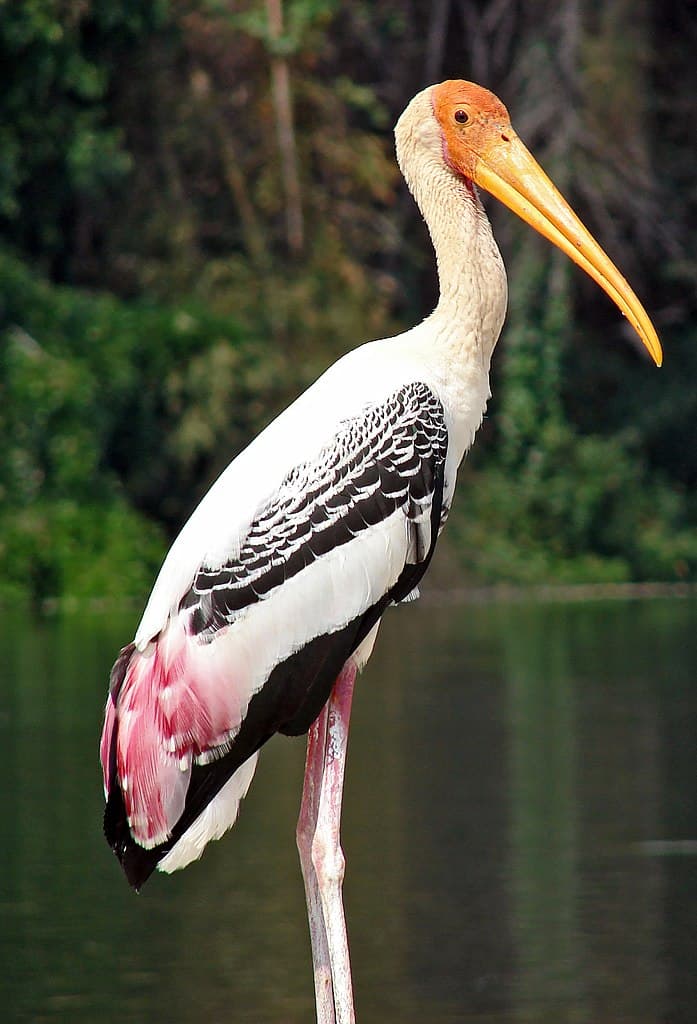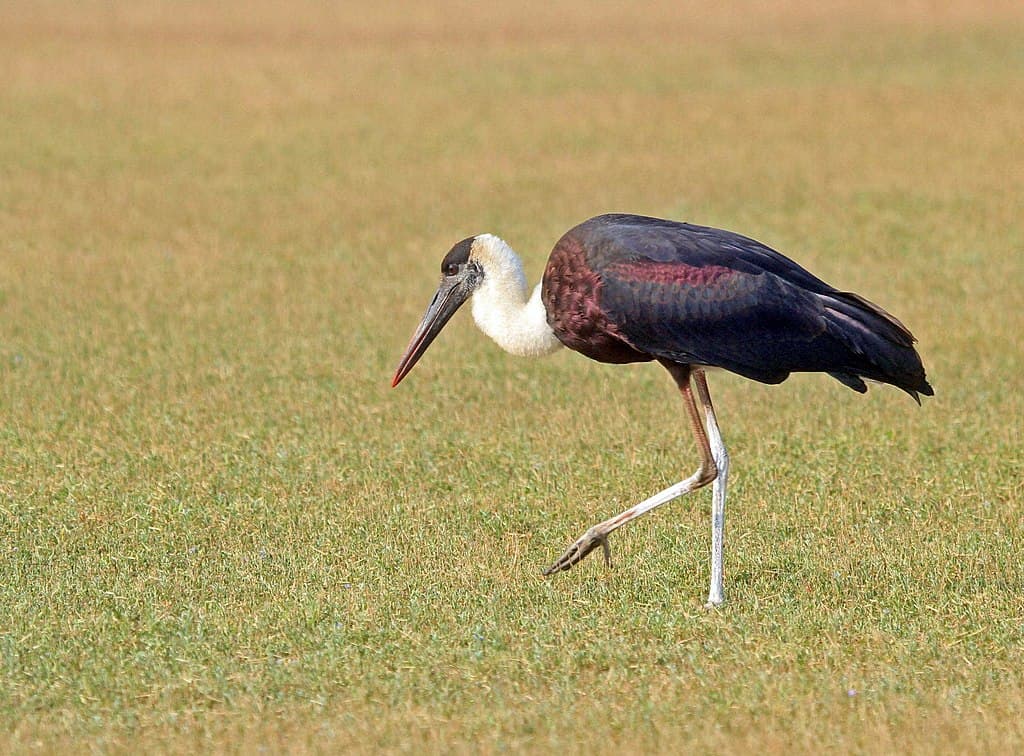Storks are one of the birds that I never knew existed in Cambodia, and it is nice to know we have them too. Actually, there are 4 stork species in Cambodia among 20 stork species in the world. Storks are large birds with long legs and necks, and they have long stout bills. Many storks are easy to recognize, so let’s find out about the 4 stork species in Cambodia with me.
Black-Necked Stork (អង្កត់ខ្មៅ/ដំបងក្រញូង)

A black-necked stork is a large bird that grows from 1.2 to 1.5 meters tall with a 2.3 meters wingspan. Adults have a glossy bluish-black iridescent head, neck, secondary flight feathers, and tail along with a coppery-brown crown. They have white back and belly, and their legs are bright red. Males have brown irises while females have yellow irises, and that is how you differentiate between the two sexes. These wading birds have large bills that they use to jab and seize most prey from the water.
Black-necked storks are widely distributed across the Indian Subcontinent and Southeast Asia, with a bit of population in Australia. Within their range, they live in wetlands habitats near rice fields and other fields where they can forage for prey. These storks also use freshwaters and natural wetland habitats such as flooded grasslands, lakes, marshes, oxbow lakes, rivers, swamps, and water meadows. As carnivores, their main diet consists of water birds including coots, darters, little grebes, northern shovelers, and pheasant-tailed jacana. Along with that, they also feed on aquatic animals such as amphibians, crabs, fish, mollusks, and reptiles.
Milky Stork (រនាលស)

A milky stork is around 91 to 97 centimeters tall, with a wingspan of 43.5 to 50 centimeters. At the same time, its tail is around 14.5 to 17 centimeters which is a very interesting feature. This stork species has a white plumage with black flight feathers and tail. During the breeding season, the white plumage turns pale creamy yellow; hence the name milky stork. Its facial skin is bare, and it is dark maroon or grayish in color, with black irregular blotches. The bare facial skin also changes to deep wine red with black markings on the lores in the mating season.
When it comes to habitats, milky storks live predominantly in coastal mangroves around parts of Southeast Asia. Specifically, they are found in Cambodia, Indonesia, Malaysia, and Vietnam. Milky storks favor habitats such as estuaries, freshwater and peat swamps, and mangroves. When it comes to where they forage, there are many including fishponds, freshwater marshes, freshwater pools, mudflats, and swallow saline. They like fish such as giant mudskippers and milkfish along with eels, frogs, and snakes.
Milky storks’ nests and young have quite several natural predators out there in the world. Brahminy kites, common palm civets, crocodiles, and monitor lizards are potential predators that raid their nests to feed on their eggs. Cat snakes, crab-eating macaques, monkey, reticulated pythons, and white-bellied sea eagles also predate their chicks and eggs.
Painted Stork (រនាលពណ៌)

A painted stork is a medium-sized bird that stands to around 93 to 102 centimeters tall. You can see that it has a white body with an orange or reddish bare head and heavy yellow beak. It has a black breast band with white scaly markings that go all the way to the under-wing coverts. The most beautiful part is definitely the pinkish bars near their tails. As for the legs, they are yellowish to red but often appear white due to their urohidrosis habit. Simply put, they defecate on their own legs as a cooling mechanism.
This beautiful stork species has a wide range across the Indian Subcontinent and Southeast Asia. Painted storks forage in flocks in shallow waters along lakes or rivers and other freshwater wetlands all seasons long. They may also be found in crop fields and irrigation canals, especially flooded rice fields during the monsoon. Painted storks mainly feed on small fish but are not limited to amphibians, crustaceans, insects, and reptiles.
The main predators to the young are crocodiles, eagles, hyenas, leopards, and tigers which occur during the breeding seasons. People also collect their eggs and capture chicks to sell to animal collectors. This stork species is not classified as Near Threatened on the IUCN Red List due to continuous population decline.
Woolly-Necked Stork (ត្រុំ /កុកពាក់អំបោះ)

The Asian woolly-necked stork is medium in size, standing around 75 to 92 centimeters tall. This stork species is rather different from the others due to its glistening black overall plumage. It even has a black skull cap, and the downy white neck is the brightest part that gives it its name. Another thing is the iridescent neck that has a coppery-purple tinge that looks absolutely beautiful. Apart from the neck, its lower belly and under-tail coverts are also white. A woolly-necked stork has a heavy blackish bill and long red legs.
Woolly-necked storks are widespread in Asia and Southeast Asia, roaming in various areas. The most common spots are agricultural areas, croplands, irrigation canals and rivers, and wetlands. Not different from other stork species, this one also feeds on amphibians, fish, insects, invertebrates, and reptiles. Sometimes they hunt in pairs while some other times they do in small groups. Their population has been declining due to habitat destruction, leading to them being Near Threatened and Vulnerable within their range.
Related Post: Heron Species In Cambodia